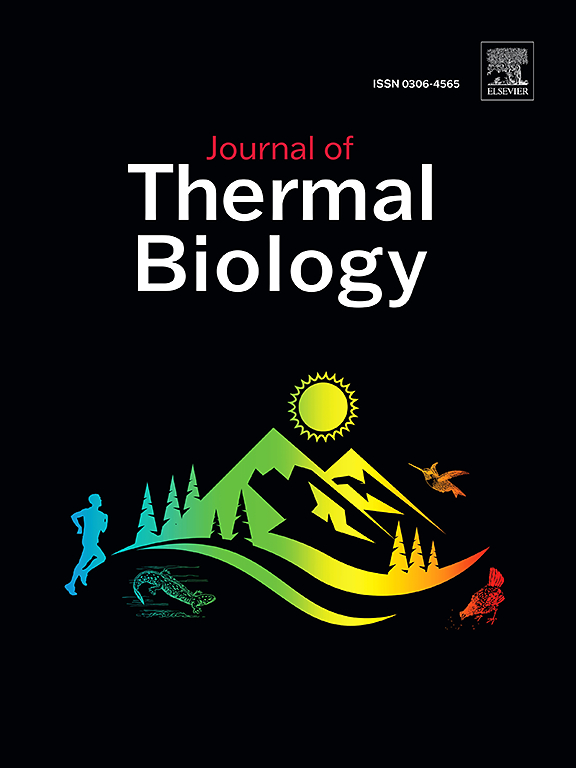用行为体温调节分析评价小鼠餐后热感觉:肉类种类及其组分的差异
IF 2.9
2区 生物学
Q2 BIOLOGY
引用次数: 0
摘要
传统中医对肉类热性的分类因肉类种类及其组分而异。本研究旨在建立基于行为体温调节的餐后热感觉评价实验体系,研究不同肉类种类及其组分的餐后热感觉,并阐明其热性质与影响热感觉的肉类活性成分之间的关系。冻干肉、脱脂肉和提取的脂肪是从马肉、鸡肉、猪肉、牛肉、羊肉和鹿肉中提取的。喂食后,将小鼠置于装有连续热梯度地板的细长室中。在30 min后,小鼠在首选温度下的累计停留时间达到一个明显的峰值,并通过检测首选温度来评估餐后热感觉。因此,纯化的肉类蛋白不被认为会影响肉类物种的餐后热感觉。相反,脱脂马肉的乙醇和水提取物引起“凉爽的感觉”,而其他肉类的提取物引起“温暖的感觉”。鸡肉和猪肉的脂肪给人一种凉爽的感觉,而牛肉和羊肉的脂肪则给人一种温暖的感觉。此外,这些脂肪中的某些剂量依赖性成分影响餐后热感觉。利用所建立的评价体系,得出肉中的提取物和脂肪参与餐后热感觉的结论,中药中肉的热性不仅取决于动物特异性成分,还取决于其含量。本文章由计算机程序翻译,如有差异,请以英文原文为准。

Evaluation of postprandial thermal feeling in mice using a behavioral thermoregulation analysis: Differences in meat species and their fractions
Classification of the thermal nature of meat in traditional Chinese medicine (TCM) varies depending on the meat species and their fractions. The objectives of this study were to establish an experimental system to evaluate postprandial thermal feeling based on behavioral thermoregulation, investigate it among different meat species and their fractions, and clarify the relationship between their thermal nature and the active meat constituents that affect thermal feeling. Freeze-dried meat, defatted meat, and extracted fat were prepared from horse meat, chicken, pork, beef, mutton, and venison. After feeding, mice were placed in an elongated chamber equipped with a continuous thermogradient floor. An obvious peak in the cumulative staying time at the mouse's preferred temperature was observed after 30 min, and the postprandial thermal feeling was evaluated by examining the preferred temperatures. As a result, purified meat proteins were not considered to affect postprandial thermal feeling among meat species. In contrast, the ethanol and water extracts of defatted horse meat induced a “cool feeling,” and the extracts of other meat species induced a “warm feeling.” Chicken and pork fat induced a cool feeling, whereas beef and mutton fat induced a warm feeling. Additionally, certain dose-dependent constituent(s) in these fats affected the postprandial thermal feeling. Using the established evaluation system, it was concluded that the extract and fat in meat are involved in the postprandial thermal feeling, and the thermal nature of the meat in TCM depends not only on animal-specific components but also on their contents.
求助全文
通过发布文献求助,成功后即可免费获取论文全文。
去求助
来源期刊

Journal of thermal biology
生物-动物学
CiteScore
5.30
自引率
7.40%
发文量
196
审稿时长
14.5 weeks
期刊介绍:
The Journal of Thermal Biology publishes articles that advance our knowledge on the ways and mechanisms through which temperature affects man and animals. This includes studies of their responses to these effects and on the ecological consequences. Directly relevant to this theme are:
• The mechanisms of thermal limitation, heat and cold injury, and the resistance of organisms to extremes of temperature
• The mechanisms involved in acclimation, acclimatization and evolutionary adaptation to temperature
• Mechanisms underlying the patterns of hibernation, torpor, dormancy, aestivation and diapause
• Effects of temperature on reproduction and development, growth, ageing and life-span
• Studies on modelling heat transfer between organisms and their environment
• The contributions of temperature to effects of climate change on animal species and man
• Studies of conservation biology and physiology related to temperature
• Behavioural and physiological regulation of body temperature including its pathophysiology and fever
• Medical applications of hypo- and hyperthermia
Article types:
• Original articles
• Review articles
 求助内容:
求助内容: 应助结果提醒方式:
应助结果提醒方式:


